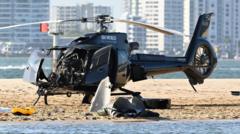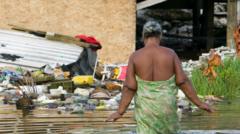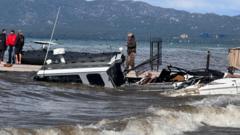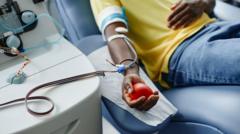Australia's Transport and Safety Bureau (ATSB) has uncovered that a malfunctioning radio antenna played a significant role in the tragic helicopter crash at Sea World, where four lives were lost, including two British tourists.
Faulty Antenna Linked to Australian Helicopter Collision Tragedy

Faulty Antenna Linked to Australian Helicopter Collision Tragedy
Investigation reveals antenna failure contributed to deadly mid-air collision at Gold Coast theme park.
The tragic incident occurred in January 2023, claiming the lives of four individuals, with two others suffering serious injuries. The ATSB's investigation into the mid-air collision revealed that a faulty radio antenna led to one pilot missing a critical communication just before the tragic event unfolded. This crash, near the popular tourist destination of Sea World on the Gold Coast, has raised significant concerns about aviation safety protocols.
The report discussed how the collision involved two helicopters—one taking off and the other landing—within mere seconds of each other. All four fatalities were aboard the helicopter that had just taken off, while the second aircraft managed an emergency landing despite its passengers sustaining a variety of injuries.
Investigation results detailed that Sea World had been attempting to enhance its helicopter operations by introducing a second helipad and larger Eurocopter EC140 B4 helicopters, yet these changes inadvertently weakened existing safety protocols aimed at maintaining separation between aircraft in flight.
Prior to the crash, the helicopter preparing for takeoff operated with a faulty antenna that failed to receive a critical radio call from the landing helicopter. Passengers were loaded onto the taking-off copter while ground crew mistakenly assured the pilot that the airspace was clear—a situation that had drastically changed by the time of departure.
The pilot of the inbound aircraft, despite noticing the departing helicopter, did not identify it as a threat due to an absence of the necessary communication, which the faulty antenna failed to convey. Consequently, the report noted that this lack of communication deprived the pilot of critical information, preventing a reassessment of the danger of a collision.
Among the deceased were Diane and Ron Hughes, a recently married couple from Cheshire, and Australian pilot Ashley Jenkinson, aged 40, who was also originally from Birmingham. Vanessa Tadros, 36, a Sydney resident, also lost her life in the collision, further adding to the tragedy of the situation.
While another helicopter returned safely after the incident, passengers aboard lauded their pilot as a “hero” for his skillful landing. The ATSB’s findings included a series of 28 recommendations highlighting essential lessons for aviation operators, emphasizing the importance of comprehensive safety measures during operational changes to avoid hazardous unintended outcomes.
The ATSB Chief Commissioner Angus Mitchell underlined that operational changes intended to enhance safety can generate unforeseen risks, urging for a stringent process of managing changes to protect overall safety in aviation operations.
Aviation accidents and incidents Australia
The report discussed how the collision involved two helicopters—one taking off and the other landing—within mere seconds of each other. All four fatalities were aboard the helicopter that had just taken off, while the second aircraft managed an emergency landing despite its passengers sustaining a variety of injuries.
Investigation results detailed that Sea World had been attempting to enhance its helicopter operations by introducing a second helipad and larger Eurocopter EC140 B4 helicopters, yet these changes inadvertently weakened existing safety protocols aimed at maintaining separation between aircraft in flight.
Prior to the crash, the helicopter preparing for takeoff operated with a faulty antenna that failed to receive a critical radio call from the landing helicopter. Passengers were loaded onto the taking-off copter while ground crew mistakenly assured the pilot that the airspace was clear—a situation that had drastically changed by the time of departure.
The pilot of the inbound aircraft, despite noticing the departing helicopter, did not identify it as a threat due to an absence of the necessary communication, which the faulty antenna failed to convey. Consequently, the report noted that this lack of communication deprived the pilot of critical information, preventing a reassessment of the danger of a collision.
Among the deceased were Diane and Ron Hughes, a recently married couple from Cheshire, and Australian pilot Ashley Jenkinson, aged 40, who was also originally from Birmingham. Vanessa Tadros, 36, a Sydney resident, also lost her life in the collision, further adding to the tragedy of the situation.
While another helicopter returned safely after the incident, passengers aboard lauded their pilot as a “hero” for his skillful landing. The ATSB’s findings included a series of 28 recommendations highlighting essential lessons for aviation operators, emphasizing the importance of comprehensive safety measures during operational changes to avoid hazardous unintended outcomes.
The ATSB Chief Commissioner Angus Mitchell underlined that operational changes intended to enhance safety can generate unforeseen risks, urging for a stringent process of managing changes to protect overall safety in aviation operations.
Aviation accidents and incidents Australia




















